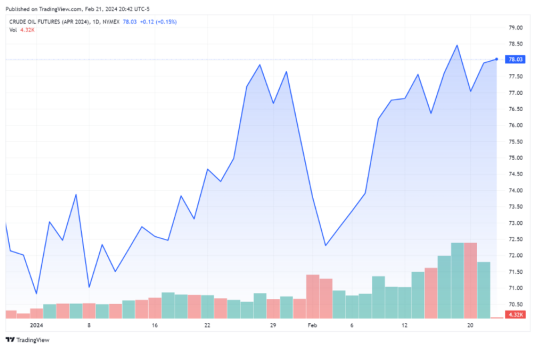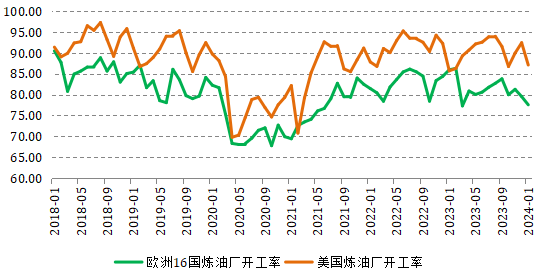Short-term Oil Market Outlook
During the Spring Festival holiday, the international energy market was full of ice and fire, and the international crude oil price rose sharply, but the international natural gas price fell sharply.
Among them, NYMEX WTI crude oil and ICE Brent crude oil rose by more than 2%, but natural gas prices in the United States and Europe fell by more than 11%. In the two trading days after the Spring Festival, the rise of international crude oil slowed down, which means that the favorable supply interference brought by the escalation of the Red Sea crisis is weakening.
Figure 1: The price of 1: WTI crude oil futures April contract rose sharply during the Spring Festival
Looking ahead to the market outlook, we believe that the rise in crude oil prices has come to an end in the short term due to factors such as the weakening of the Fed's interest rate cut expectation, weak demand for crude oil consumption in Europe and America and the recovery of inventories.
However, with the support of favorable factors such as financial subsidies, biofuels replace traditional fossil fuels, so it is difficult for the crude oil market to have a large-scale shortage. The driving force of crude oil rise in the future comes from the return of investment demand after the Federal Reserve cut interest rates, rather than the growth of consumer demand under the weak global economic growth.
Global crude oil supply is still growing
In January, the global crude oil supply did not decline due to OPEC + 's voluntary production reduction, but increased. According to the data released by OPEC, the global crude oil supply reached 101.8 million barrels per day in January and 100.9 million barrels per day in December last year, mainly due to the increase in production in non-OPEC + countries such as the United States.
OPEC crude oil production is declining. According to the data released in OPEC's latest monthly report, OPEC crude oil output decreased by 8.5% year-on-year in January and 1.3% month-on-month compared with last December. Among them, the crude oil output of Saudi Arabia and UAE increased by 25,000 barrels per day and 31,000 barrels per day respectively in January. Iraq's crude oil output in January decreased by 98,000 tons compared with last December, but it was still higher than the quota.
Crude oil production surged in January in the United States, Canada and Guyana, as well as in non-OPEC countries such as Brazil. Although Brazil joined OPEC + in January, it is not subject to production quotas.
Russian crude oil achieved its production reduction target in January, while US crude oil production remained high. According to the data of Baker Hughes, an oilfield service company, the number of oil rigs in the United States rebounded in 2023, still lower than the peak of shale oil production capacity expansion in the United States in 2018-2019.
However, due to technological progress, the output of shale oil single well in the United States has increased and its life has been prolonged, which means that the output of crude oil in the United States will not decline due to the decrease in the number of wells drilled, but will remain at a certain high level. In the week ending February 9, US crude oil production remained at 13.3 million barrels per day.
Geopolitical crisis has little impact on oil production
From the statistical data, the Red Sea crisis did not affect the global crude oil production, but the transportation of crude oil, and the short-term global supply may cause interference.
At present, OPEC has more remaining capacity after continuous production reduction, exceeding 6.4 million barrels per day. Unless the Red Sea crisis causes more Arab countries to get involved in war, OPEC's decline in crude oil production is caused by voluntary production reduction. The impact on crude oil lies in the price difference structure. At present, NYMEX WTI crude oil and ICE Brent crude oil both show Back structure, that is, the contract price in recent months is higher than that in far months.
Two years after Western countries imposed sanctions on Russia, although Russian crude oil exports declined, they did not interrupt, and the geopolitical crisis stimulated the expansion of American crude oil exports. Reuters quoted Kpler, a data and market analysis company, and LSEG2, a data provider, as saying on February 19th that three oil tankers loaded with Russian Sokol crude oil stranded at sea due to payment problems and Western sanctions have started to sail to China and India.
The weak demand for crude oil has not changed
From the perspective of economic growth fundamentals, both Europe and the United States showed the characteristics of slowing down in the first quarter, among which the German economy experienced a technical recession in the fourth quarter of last year, and Japan also experienced negative growth for two consecutive months in the fourth quarter of last year.
The United States accounts for 20.31% of the world's oil consumption, and is the largest oil consumer in the world. Its economic slowdown will inevitably lead to the decline of American crude oil consumption. According to the published data, the weakening characteristics of American economy are obvious in the first two months of 2024, and American consumer demand is likely to weaken in 2024.
Figure 2: The operating rate of refineries in Europe and America is obviously weaker
The growth point of crude oil demand comes from two sources: First, the United States replenishes its strategic reserves. As of February 9, the strategic crude oil reserves of the United States were 359 million barrels, which was higher than the low of 347 million barrels set in July last year, but it was still at a historical low. Replenishing crude oil reserves will become one of the top tasks of the US Department of Energy in the future.
Second, consumption growth in China and India. Among them, the Spring Festival factor leads to a decline in the operating rate of Chinese refineries, and the demand for crude oil weakens seasonally, which is expected to pick up in March. As of February 8th, the operating rate of Shandong refining has dropped to 56.57%. India's consumption remained stable. The Oil Planning and Analysis Group under the Ministry of Oil announced that the country's fuel consumption in January totaled 20.04 million tons, up from 18.51 million tons in the same period last year and basically flat compared with 20.05 million tons in December.
The substitution of biofuels for crude oil consumption can not be ignored. Bioenergy production is growing strongly, spurred by national regulations such as the US Inflation Reduction Act and government subsidies. By building new production facilities and transforming oil refineries, the renewable diesel production capacity in the United States tripled between 2021 and 2023, and is expected to further double to 17.4 million tons per year by 2025.
To sum up.
With the continuous escalation of the Red Sea crisis, the price of international crude oil is firm due to the rising transportation cost, and the price difference structure continues to show the characteristics of near high and low, but the supply has not decreased, and the demand is weak due to the economic slowdown and the expected cooling of the Federal Reserve's interest rate cut, and the crude oil price has a short-term upward trend.
In the future, it is necessary to see the Federal Reserve cut interest rates when crude oil resumes its rise, and there is a risk of decline in Foreign investors can use CME group's WTI crude oil weekly options to manage risks, such as buying put options to prevent the risk of price decline.
WTI crude oil weekly options enable traders to accurately manage the fluctuation risks caused by weekend news headlines, OPEC + meetings, and midweek announcements, and have the characteristics of short maturity date and low premium, so they are quite popular among investors.
$NQ100 Index Main Connection 2403 (NQmain) $$SP500 Index Main Connection 2403 (ESmain) $$Dow Jones Main Link 2403 (YMmain) $$Gold Main 2404 (GCmain) $$WTI Crude Oil Main Line 2404 (CLmain) $
Disclaimer: Investing carries risk. This is not financial advice. The above content should not be regarded as an offer, recommendation, or solicitation on acquiring or disposing of any financial products, any associated discussions, comments, or posts by author or other users should not be considered as such either. It is solely for general information purpose only, which does not consider your own investment objectives, financial situations or needs. TTM assumes no responsibility or warranty for the accuracy and completeness of the information, investors should do their own research and may seek professional advice before investing.



